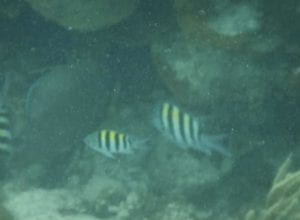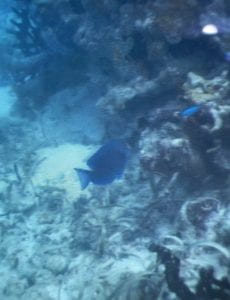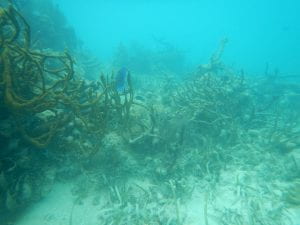Hey y’all! It’s Michiel again : )
I’m sure you guys already know that the day started with everyone waking up and getting breakfast by 7. After waking up this morning and getting breakfast, everyone quickly put on their snorkel gear, got their transects, quadrats, and clipboards, and boarded the boat to go out to a non-MPA reef. There, we collected data for the research question I talked about on June 11. The reef was a pretty good depth, not to shallow or too deep, but it had a lot of fire sponge and fire coral. Thankfully, I managed not to touch any while I was there. It also had a lot of dead coral and there were very few fish. I remember seeing two Cocoa Damselfish (Stegastes variabilis), but I can’t remember seeing any other fish I could identify. After, Ava and I laid out our transect and counted alive and dead coral in our quadrat, the entire class began collecting sea urchins for 10 minutes. This place was full of sea urchins; I ended up getting 11, but some people were able to find a lot more. We ended up with 177 sea urchins after only 10 minutes.
After this reef, we went to a much nicer, deeper reef where the class had a chance to snorkel without the pressure of collecting any data. This was our last time to snorkel on the trip, and I’m really happy with the reef they ended up taking us too. The coral in the area was beautiful, and I saw so many fish. In terms of herbivorous fish, I saw a bunch of Cocoa Damselfish (S. variabilis), some really large Sergeant Majors (Abudefduf saxatilis) – they were about 20 cm – Threespot Damselfish (S. planifrons), and Bicolor Damselfish (S. partitus). I also saw a Blue Tang (Acanthurus coeruleus) and a male Bluelip Parrotfish (Cryptotomus roseus), both of which I followed for a while to get a good picture. I got some fine-ish pictures of the Blue Tang, but I couldn’t get any good ones of the parrotfish because the parrotfish kept going all over the reef, moving through coral so fast that I could barely keep up with it. All of these fish were really hard to get pictures of because they tend to hide within the coral whenever you approach them.

After we left that reef, we compiled all of the data we’ve collected over the past couple of days. We were able to conclude that there is a correlation between a high percentage of live coral coverage and less sea urchins. However, we didn’t see any correlation between the amount of urchins and whether we were collected at an MPA or a non-MPA. We think this may be due to our ability in collecting sea urchins improving as we went from reef to reef. This would explain why we collected so few sea urchins from the first non-MPA site we went to, which probably skewed our results. After determining all of this, we put all of our information on a poster and presented our project to Scott and Adrienne.
Later in the day (after lectures and dinner) we dissected lionfish. My group was given a really tiny lionfish, which was challenging, but my confidence in my dexterity skills skyrocketed after I saw how well I did on the dissection. The most interesting part of the dissection was opening its stomach to examine its content. We were able to see some invertebrate organism within it that measured about 2.1 cm. After dissecting the fish, Scott took them, fileted them, and made ceviche. The ceviche was delicious, and we were all happy that we were simultaneously having a wonderful snack and contributing to the betterment of our marine environment.
After the ceviche, we worked on our assignments and got ready for bed. This was the last day of the reef! I’m sad it’s over – I had so much fun snorkeling – but I’m excited for everything I’m going to learn in the rainforest.


